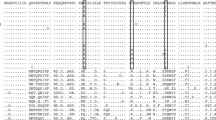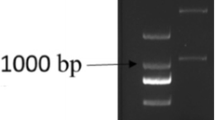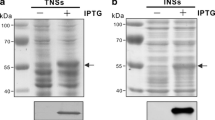Abstract
Monoclonal antibodies were raised against Frankia ORS020607, a strain isolated originally by H.G. Diem from nodules of Casuarina equisetifolia from Senegal. One of these antibodies, mAb8C5, was shown by ELISA to have high, but not absolute specificity for ORS020607. This antibody was employed to investigate the mobility and persistence of ORS020607 in plantations of C. equisetifolia. Seedlings were inoculated in pots of sand in a forest nursery with ORS020607, with local crushed nodule suspensions or were left uninoculated. They were planted out after 5 months in experimental plots on a moderately fertile black soil site and on a low organic, oxidised red soil site. Compared with crushed nodule inoculated seedlings or uninoculated controls, growth of seedlings at transplant was improved by inoculation with Frankia ORS020607. However, 4 years after transplant to experimental plots, the growth of trees receiving different treatments was similar. The possibility that movement of ORS 020607 between treatment plots contributed to new nodulation and enhanced growth of uninoculated trees was tested using mAb8C5 in ELISA of Frankia mycelium, extracted from the nodules of trees of the three treatments. No significant differences in reactivity were detected between nodules from uninoculated and ORS020607 inoculated trees at either the black or the red soil sites, showing that ORS020607 moved between treatment plots at both sites. However, at both sites, nodules from plots of trees that were inoculated originally with local crushed nodules gave reactions in ELISA that were significantly lower than values for ORS020607 inoculated trees, possibly due to the competitive effects for new nodulation of enhancement of the indigenous population of Frankia. Serological techniques using antibodies of high specificity against Frankia strains have value for rapid screening of field samples as a preliminary for further analysis by more discriminatory techniques based on assays of genetic polymorphisms.
Access this chapter
Tax calculation will be finalised at checkout
Purchases are for personal use only
Preview
Unable to display preview. Download preview PDF.
Similar content being viewed by others
References
Baker D D, Pengelly W L and Torrey J G 1981 Immunological analysis of relationships among the isolated frankiae (Actinomycetales). Int. J. Syst. Bacteriol. 20, 201–220.
Benson D R 1982 Isolation of Frankia strains from alder actin- orhizal root nodules. Appt Environ. Microbiol. 44, 461–465.
Diem H G and Dommergues Y R 1990 Current and potential uses and management of Casuarinaceae in the Tropics and sub-Tropics. In The Biology of Frankia and Actinorhizal Plants. Eds. C R Schwintzer and J D Tjepkema. pp. 317–342. Academic Press, San Diego, USA.
Diem H G, Gauthier D and Dommergues Y R 1982 Isolation of Frankia from nodules of Casuarina equiseaifblia. Can. J. Microbiol. 28, 526–530.
Giersch T and Hock B 1990 Production of monoclonal antibodies for the determination of s-triazines with enzyme immunoassay. Food Agric. Immmnol. 2, 85–97.
Handley L L, Daft M J, Wilson J, Scrimgeour C M, Inglcby K and Sattar M A 1993 Effects of the ecto-and VA-mycorrhizal fungi Hydnagium carneum and Glomus clarum on the 6N and 8C values of Eucalyptus globulus and Ricinus communis. Plant Cell Environ. 16, 375–382.
Hooker J E and Wheeler C T 1987 The effectivity of Frankia for nodulation and nitrogen fixation in Alnus rubra and Anus glutinosa. Physiol. Plantarurn 70, 333–341.
McEwan N R, Gould E M, Lumini E, McNeill J D and Wheeler C T 1998 Competitivity and persistence of Frankia in a managed environment. In Nitrogen Fixation with Non-Legumes. Eds. K A Malik, S. Mirza and J K Ladha. pp. 315–326. Kluwer Academic Publishers, Dordrecht.
McEwan N R, Gould E M O and Wheeler C T 1999 The compelitivity, persistence and dispersal of Frankia strains in mine spoil planted with inoculated Alnus rubra. Symbiosis 26, 165–177.
McNeill J D, Hollinsworth M K, Mason W L, Moffat A J, Sheppard
U and Wheeler C T 1989 Inoculation of Alnus rubra seedlings to improve seedling growth and forest performance Forestry Commission Research Information Note 144, 3 pp.
Sadowsky M J and Graham P J 1999 Soil Biology of the Rhizobiaceae. In The Rhizobiaceae. Eds. H P Spaink, A Kondorosi and P J J Hooykaas. pp. 155–172. Kluwer Academic Publishers, Dordrecht, The Netherlands.
Sempavalan J, Wheeler C T and Narayanan R 1996 The isolation and characterisation of Frankia from nodules of Casuarina equisetifolia (L.) from Tamil Nadu. Indian J. Microbiol. 36, 149–151.
Wheeler C T, Tilak M, Scrimgeour C M, Hooker J E and Handley L L 2000 Effects of symbiosis with Frankia and arbuscular mycorrhizal fungus on the natural abundance of 15N in four species of Casuarina. J. Exp. Bot. 51. 287–297.
Wheeler C T, Hughes L T, Oldroyd J and Pulford I D 2001 Effects of nickel on Frankia and its symbiosis with Alnus glutinosa ( L.) Gaertn. Plant Soil 231, 81–90.
Author information
Authors and Affiliations
Corresponding author
Editor information
Rights and permissions
Copyright information
© 2003 Springer Science+Business Media Dordrecht
About this paper
Cite this paper
Hahn, A., Hock, B., Kesavan, A., Animon, M.M., Narayanan, R., Wheeler, C.T. (2003). The production and utilisation of monoclonal antibodies for identification of a Frankia strain utilised as inoculum for Casuarina equisetifolia . In: Normand, P., Dawson, J.O., Pawlowski, K. (eds) Frankia Symbiosis. Developments in Plant and Soil Sciences, vol 100. Springer, Dordrecht. https://doi.org/10.1007/978-94-017-1601-7_4
Download citation
DOI: https://doi.org/10.1007/978-94-017-1601-7_4
Publisher Name: Springer, Dordrecht
Print ISBN: 978-90-481-6380-9
Online ISBN: 978-94-017-1601-7
eBook Packages: Springer Book Archive




